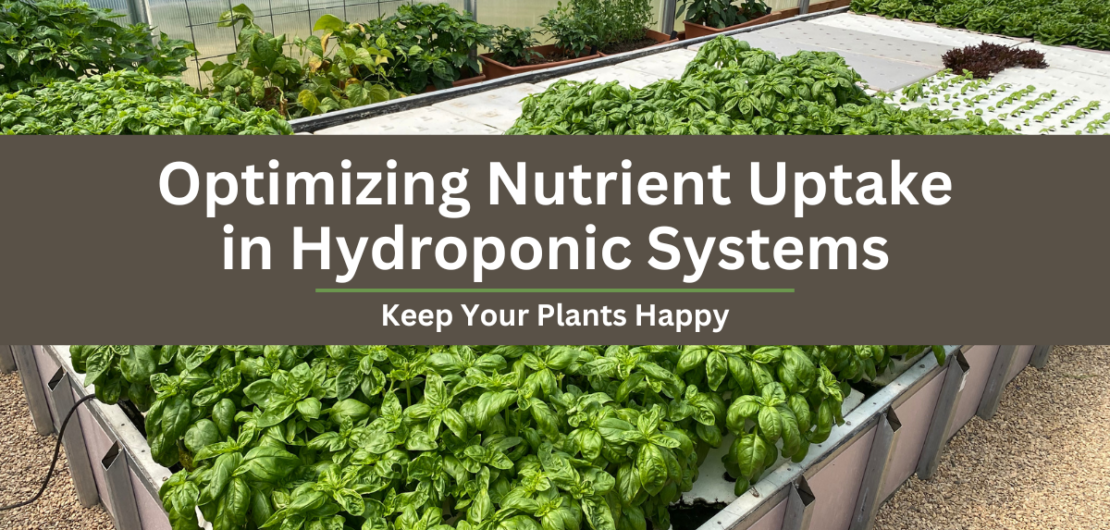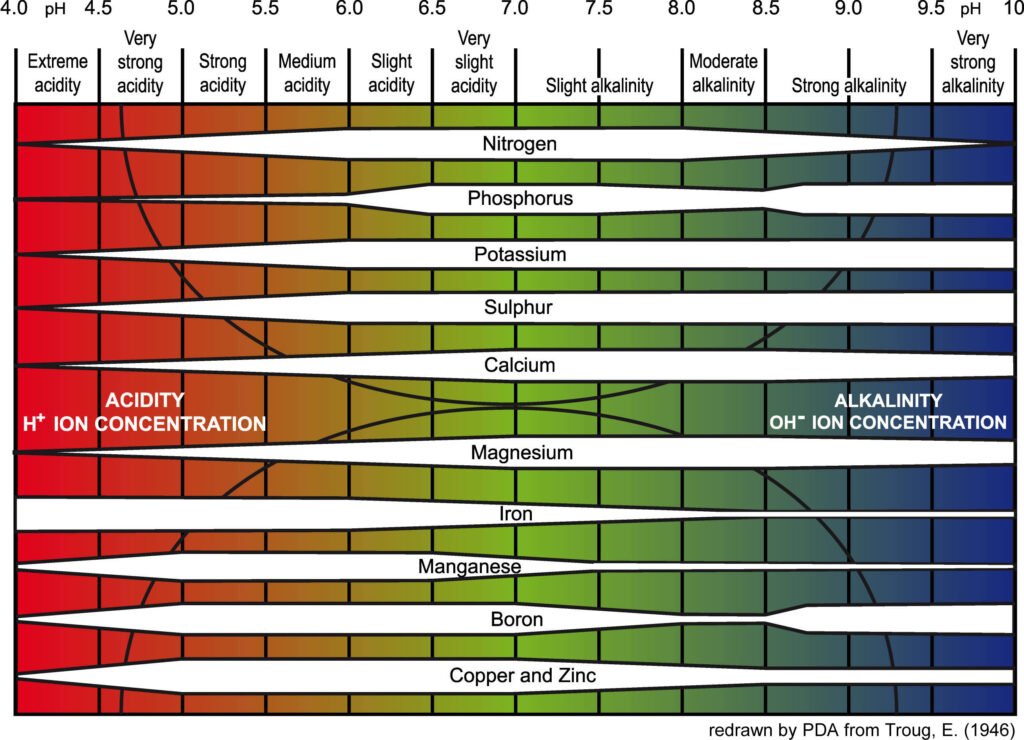
Introduction
In hydroponic growing, plants need water and nutrients to grow strong and healthy. But just having nutrients in the water is not enough—plants can still miss out on what they need if the growing conditions aren’t right. This guide explains how to make sure your plants can actually absorb the nutrients you give them and what steps you can take to avoid common problems.
Why pH Matters for Plant Nutrition

pH tells us how acidic or basic your water is. Every plant has a “sweet spot” where the pH helps them absorb nutrients from the water. If the pH is too high or too low, some nutrients will be “locked out,” meaning the plant can’t use them even though they’re in the water.
For example:
- Iron and manganese are harder for plants to take in when the pH is too high.
- Phosphorus may get locked out if the pH is too low.
That’s why it’s important to check and adjust your pH regularly, keeping it in the best range for the plants you’re growing.
Adjusting pH
In general, we recommend using products that are made for pH adjustments in hydroponics. For hobby-size systems, you likely won’t go through much of these so the cost is worth it to have a good product. For larger systems, or if you want to make your own pH Up and pH Down products, we recommend using either Nitric or Phosphoric Acid to lower pH, and Potassium Carbonate for raising pH.
EC (Electrical Conductivity) and Plant Health
EC measures how much “stuff” (salts and nutrients) is dissolved in your water. It helps tell you if your plants are getting too little or too much nutrition.
- If your EC is lower than the target level, that means your plants aren’t getting enough nutrients, which can slow their growth and cause yellow leaves. When EC is too low, add some of your nutrient blend (following recommendations on the product) to increase the EC to the desired amount.
- If your EC is higher than the target level, that means there are too many salts in the water. This can stress your plants, cause leaf burns, or at higher levels prevent plants from absorbing nutrients properly. For example, potassium, calcium, and magnesium all use similar uptake receptors on plants, so if one in particular (or the EC level overall) is too high it can minimize how well the plant absorbs other nutrients. At very high levels, an EC that’s too high can even prevent the plant absorbing water.
Different crops have different EC needs, so it’s important to know what EC is best for your plants and check it often. In general, most crops will fall between 1.2-2.5, but there are numerous resources online with very crop-specific recommendations on EC targets.
When to Check pH and EC
We recommend checking the pH and EC of your system 2-3 times per week and adjusting as necessary to keep your plants happy and healthy.
Hydroponic Nutrients Balance Over Time
Even if your pH and EC seem okay, there’s something else to watch for: nutrient imbalances. Plants don’t use all nutrients at the same speed. While some, like nitrogen, are in high demand from a plant for vegetative growing, others may only be used a little at a time. This will often even change depending on what stage of growth your plants are in.
For example, when growing fruiting or flowering crops, they will need a lot of nitrogen early on for vegetative growth, but then need more potassium and phosphorus later to support flowering and fruit growth.
If you just keep adding your usual fertilizer mix, you won’t fix these imbalances. Over time, this can hurt plant growth or cause nutrient problems.
Example: Nutrient Drift Over Time
To illustrate this issue, let’s use a sample nutrient solution where our target Nitrogen is 160 ppm and our target calcium is 180 ppm. These two would have an approximate combined EC of 0.34. Each week, our plants consume 15 ppm of Nitrogen and 5 ppm of Calcium. Now let’s say with our standard nutrient blend we’re adding enough to maintain the right EC, but that only provides 10 ppm Nitrogen and 10 ppm Calcium. That means each week our EC looks correct after adjusting, but our nitrogen is actually decreasing by 5 ppm each week and our calcium is increasing 5 ppm each week.
Table: Nutrient Balance Drift Over Time
| Week | Nitrogen Level (-5 ppm weekly) | Calcium Level (+5 ppm weekly) | Approximate EC |
| Start | 160 ppm | 180 ppm | 0.34 |
| Week 1 | 155 ppm | 185 ppm | 0.34 |
| Week 2 | 150 ppm | 190 ppm | 0.34 |
| Week 3 | 145 ppm | 195 ppm | 0.34 |
| Week 4 | 140 ppm | 200 ppm | 0.34 |
| Week 5 | 135 ppm | 205 ppm | 0.34 |
You can see from the example above that even though we are watching our EC and maintaining the same level, since we haven’t adjusted the blend of what we’re adding, the balance of nutrients changes over time.
This same issue relates to a previous topic we covered on managing sodium accumulation in hydroponics.
Managing Nutrient Balance: Big Systems vs. Small Systems
How you manage nutrients and prevent imbalances depends on how big your system is:
- “Big” systems: For larger, business-size systems, it’s smart to send water samples to a lab every 1 to 3 months. The lab will tell you exactly what’s missing or is getting too high, so you can adjust your nutrient mix. Our deep water culture ponds range from 2,000-4,000 gallons, so we don’t want to just dump all that solution any more than we have to. It’s more cost-effective to buy specific nutrient salts and adjust our recipe to correct imbalances.
- “Small” systems: For smaller, more personal use or hobby setups, it’s usually easier and cheaper to just drain and refill the system with fresh nutrients regularly.
Example: Management Decision Process
Let’s say you’re running a 100-gallon ebb-and-flow system. The first step is to calculate the cost of completely replacing the nutrient solution. For this example, we’ll assume it costs $10 for 100 gallons worth of nutrients for a new fill on the system. The cost of a lab sample is $55, which we would want to do no less than every three months to keep nutrients balanced. If we empty and replace the system once a month, then our total cost for three months is $30. Since this is less than the cost of lab sampling, it makes more sense to empty and refill the system.
Repeating this exercise with a 400-gallon system, at $10 per 100 gallons, a new fill on the system would be $40. Dumping/refilling the system once a month means the 3-month total cost will be $120. Instead, doing one lab sample in that timeframe would be $55, so it makes more sense to do a lab sample and then adjust the nutrient blend to keep nutrients in balance.
3 Simple Steps for Optimizing Nutrient Uptake in Hydroponics
- Keep pH in the right range for the plants you’re growing.
- Keep EC at the right level to make sure plants don’t get too little or too much nutrition.
- Rebalance your system often:
- In big systems, test and adjust the nutrients.
- In small systems, drain and refill to reset everything.
By doing these three things, you’ll give your plants the best chance to take up the nutrients they need—and grow strong, healthy, and productive.